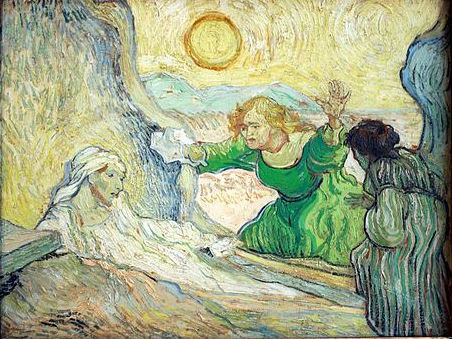AM Psalm 2, 110:1-5(6,7)
Joshua 2:2-9; Eph. 6:10-20; John 11:17-27,38-44
Eve of Epiphany:
As much as I love the NRSV translation of the Bible, the story of Lazarus is one of those stories where I truly miss the King James Version language. I’m sorry, but “Lord, already there is a stench” just doesn’t hold a candle to “Lord, by this time he stinketh.” (I’ll also add that, having done my obligatory obligations as a pathology resident through the medical examiner’s office, I have a pretty realistic idea of just how much “stinketh” we are talking about here. There’s a reason I chose surgical pathology and its nice little buckets of formalin-fixed tissue over the world of forensic pathology.)
We are never quite sure what to do with that vivid bit of information in the story, other than maybe a few muffled titters or a little nose-wrinkling and going “Ewwww!” Yet, I believe it’s an integral part of the story. It leaves us no room to rationalize our way out. In this story, there is zero chance Lazarus is comatose or in a semi-vegetative state. He is unmistakably, unequivocally, irrefutably four days dead. John wants to make this clear this is not a resuscitation story (and that’s not to diss resuscitation, which is a miracle in its own right). This is a resurrection story–and there’s a world of difference. It also serves as a portent to the parallel story that will occur–Jesus’ own death, burial, and resurrection.
Yet the fact remains–the stench has value in this story, because it reminds us of the exact boundaries of our very human limitations when it comes to faith. Even the most faithful of us has a place where our faith hits the wall, and for every one of us, it’s intertwined with our own life experiences and our own history of grief and loss. Our head might tell us that theoretically, Jesus can heal anything, but there’s a place for each of us where stink in our nostrils of the grief or despair we hold closest to our heart tells us, “It’s just too much to ask for, for Jesus to heal that.”
It’s easier for us to simply entomb that grief and despair, wall it up, and simply steer clear of it. It might even hurt so much, that we’d rather not even have Jesus show up to heal it. Mary and Martha’s responses illustrate two very common reactions to that kind of pain. Some of us might take Martha’s response–”I wouldn’t open that if I were you, Jesus”–or some of us might take Mary’s response. I can’t help but think how in a normal situation, Mary would have jumped at the chance to see her friend Jesus–yet she stayed home. I wonder if her grief was such that she couldn’t even bear to leave the house, even to see her beloved friend. Martha could go to the tomb, but she was not ready to have the stone removed. Mary wasn’t even ready to get out of the house, let alone go to the tomb.
Yet what we see in this story, is where we can’t go, Jesus can. Jesus is clearly grieving too–grieving deeply for his friend Lazarus–yet he dives right into this ocean of grief that has entombed Lazarus’ sisters, and, presumably, his friends and relatives, and goes about the business of resurrection. Perhaps this is what we need to hang onto, and this is what constitutes the good news. Where we can’t go, in the cacophony of our own grief, Jesus can. The stone we don’t dare move, Jesus will. What we believe is irrefutably dead in our own souls, Jesus can resurrect.
At the same time, that stench behind the stone isn’t only about the deaths we suffer in our own psyches–the stench tells us that this is about death itself, and that in Christ’s own resurrection, death’s finality is abolished, and how Christ’s reversal of death is not simply about the preservation of some spiritual bit of us that somehow “survives” death. This is about how all of us belongs to God–every muscle, sinew, and organ, as well as every thought and hope that flies out of our neurons–and God’s promise of a new, dazzling body that makes our mortal bodies of flesh pale in comparison, that we can scarcely comprehend.
What lies behind the stone in your heart’s tomb, and what might that look like, resurrected?
Maria Evans splits her week between being a pathologist and laboratory director in Kirksville, MO, and gratefully serving in the Episcopal Diocese of Missouri as Interim Pastor at Church of the Good Shepherd and Chaplain of the Community of St. Brigid, both in Town and Country, MO.

